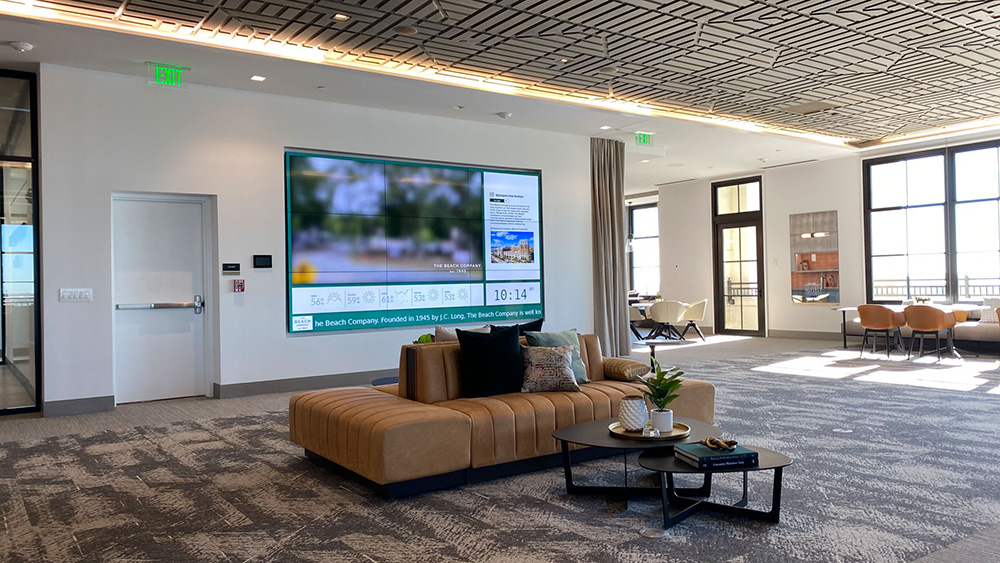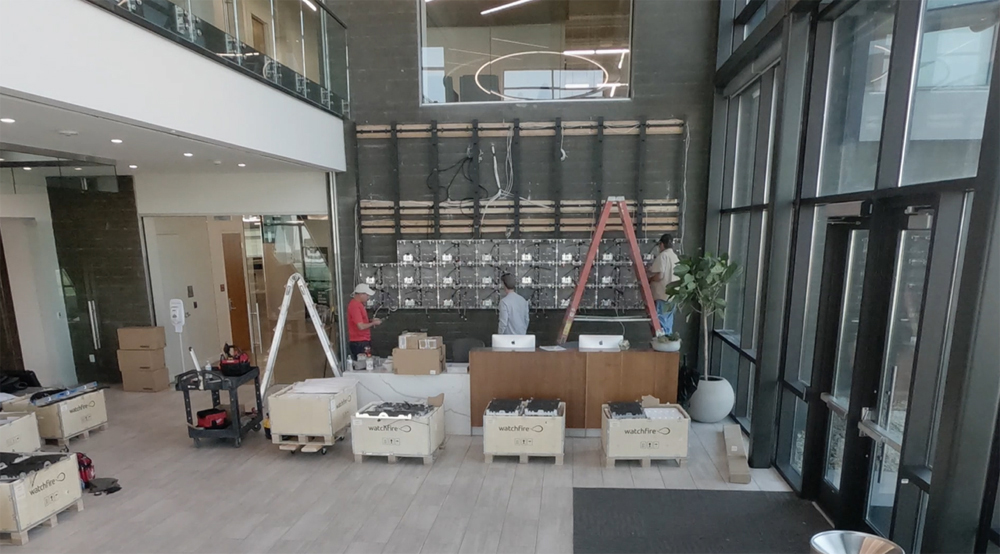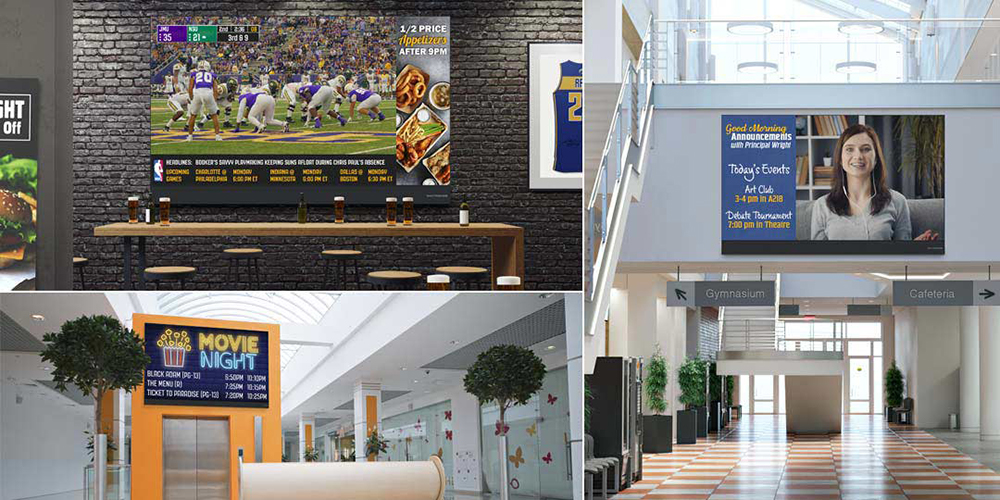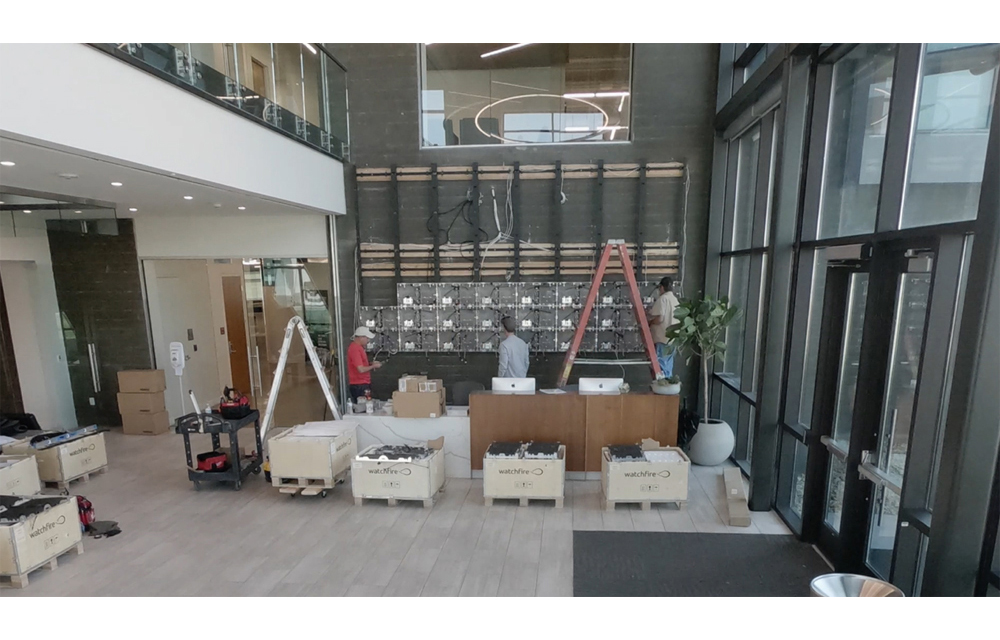 An outdoor digital signage display can lead to several roles sign shops can play in a project. Photo: Thinksign.
An outdoor digital signage display can lead to several roles sign shops can play in a project. Photo: Thinksign.
In the realm of sign shop roles within digital signage projects, the scope often involves electrical work and installation. Yet, securing and maintaining these jobs require proactive efforts from sign makers to not only acquire projects but also to sustain their involvement in the evolving field.
Continuous improvement manager at Vantage LED in Ontario, California, Deacon Wardlow, advises against merely seeking vendors and emphasizes the importance of finding partners. With an abundance of companies selling digital solutions, it’s crucial to go beyond getting a price quote and ensure the long-term satisfaction of the client. Wardlow emphasizes that digital signage is not a one-size-fits-all solution, and a successful program should address current client needs while allowing room for future growth.
According to Paul Hughes, national sales manager at ThinkSIGN, a majority of digital signage project opportunities for sign shops come from local networking and customer relationships. While leads are traditionally generated through these channels, manufacturers are increasingly sharing leads as well. Roxanna McCoy, director of Operations at ThinkSIGN, highlights the impact of word of mouth and community involvement in steering companies toward digital signage updates.
McCoy acknowledges the initial challenges for sign companies entering the digital signage realm but underscores the industry’s sustained growth and evolution. She suggests that staying relevant requires providing what customers want, emphasizing the importance of adapting to digital trends.
Looking ahead, Taylor Nilson, on-premise market manager at LED display manufacturer Daktronics, cautions sign shops against assuming the business landscape will remain static. He stresses the necessity of developing a forward-thinking five-year plan, especially in the face of evolving expectations. Nilson anticipates that high-value accounts will seek comprehensive digital marketing plans, encompassing both indoor and outdoor spaces with various digital applications.
To aid sign shops in understanding how to navigate the digital signage landscape, the industry emphasizes the need for proactive preparation. This includes not only acquiring the necessary technical skills for installation and electrical work but also fostering partnerships, staying informed about industry trends, and developing a forward-looking business strategy to meet evolving client demands.

Banks use outdoor digital signage which could lead sign shops to opening the door for interior installations as well.
Sign shops can actively engage in the digital signage market through various avenues, such as building relationships with manufacturers or integrators. Another effective approach is through existing partnerships with end-customers. For instance, consider a scenario where a sign shop works closely with a regional bank that has multiple branches. During regular meetings, it is crucial to delve deeper into the bank’s signage needs and inquire about ongoing initiatives and goals.
According to Nilson, understanding the client’s plans for the next year or two can reveal potential opportunities for digital signage involvement. Essential questions to pose include the reasons behind sign replacements, whether it’s part of a rebranding effort, and the interior strategies. Nilson emphasizes the importance of asking, “What else can we do for you as part of this overall project and strategy?” This proactive approach allows sign shops to offer additional services, such as integrating LCD screens inside with the external digital signage for consistent branding.
Being proactive is highlighted as a critical factor in sign shops venturing into digital signage. Nilson emphasizes that taking the initiative significantly increases the chances of winning a project, especially if the idea originates from the sign shop. Waiting to be approached by an end-customer can result in missed opportunities, as potential clients may have already conducted substantial research and identified potential partners.
For those clients who approach sign shops seeking digital signage solutions, Nilson advises against providing only the basic information requested. Instead, sign shops should be more assertive in showcasing the range of services they can offer. Simply providing pricing without exploring additional possibilities is considered a mistake. Hughes echoes this sentiment, emphasizing the need for follow-up and a systematic approach to closing the deal. Lack of proactive engagement and failure to inquire further about the client’s needs are common pitfalls that sign shops should avoid in the competitive digital signage market.
 With indoor displays, you have to make sure everything is flush and level so that the cabinets can go together.
With indoor displays, you have to make sure everything is flush and level so that the cabinets can go together.
In addition, neglecting to showcase both hardware and software demonstrations can hinder the understanding of proposed solutions for end-users. McCoy emphasizes the importance of presenting software demos to potential customers, as it allows them to witness the limitless possibilities offered by digital signage compared to traditional one-way messaging methods.
McCoy suggests illustrating the potential for global communication, daily message updates, and unlimited flexibility with digital signage. He questions why anyone would settle for less when presented with such expansive capabilities.
Hughes expresses frustration with sign shops that under-utilize their partnership, often limited to sending quotations without providing demonstrations or assistance. Active participation and demonstrations significantly improve the closure rate for signage projects, with Hughes noting a 50 percent increase in success when sign shops collaborate more effectively.
Addressing the potential challenge of sticker shock, McCoy advises sign shops to justify the higher cost by emphasizing the unparalleled influence digital signage has on audiences compared to other forms of signage. Failing to demonstrate this value could result in the customer opting for a more affordable option, leading to missed opportunities.
Wardlow emphasizes the role of manufacturers as experts in the field, not merely one-stop shops. He believes manufacturers should collaborate with sign shops, providing them with the necessary tools to succeed in the market. While some sign companies may be content with a buyer/vendor relationship, Wardlow argues that the evolving market complexity demands knowledgeable partners rather than those solely focused on making sales. As the market becomes more intricate, sign shops benefit from collaborative partnerships that offer expertise, guidance, and innovative solutions.
 Sign shops typically are involved with outdoor aspects of a digital signage project–such as an EMC.
Sign shops typically are involved with outdoor aspects of a digital signage project–such as an EMC.
Sign shops today have diverse roles they can assume in digital signage projects. They can act as straightforward installers, collaborate with other companies, or even become competitors. A common collaboration involves working with A/V integrators, where sign shops often handle outdoor aspects, while A/V integrators focus on the interior.
Jim Vasgaard, National Sales Manager-AV Partner Development at Daktronics, points out that A/V integrators excel in comprehensive knowledge of various products, business operations, and computer network support. On the other hand, sign companies specialize in the construction aspects, such as welding and fabrication, and are adept at navigating the permitting process. Sign shops have a significant advantage in breaking into this field due to their expertise in construction and permits, areas where A/V integrators might feel less comfortable.
Collaboration requires sign shops to pose discovery questions to A/V integrators, aiming to understand not only the desired product but also the overall outcome. Having a clear strategy is crucial for successful collaboration in both indoor and outdoor spaces.
Nilson emphasizes the importance of sign shops expanding their expertise beyond exterior digital signs. Indoor digital work should also be within their capabilities to avoid missing opportunities or losing accounts. While outdoor displays typically involve a single cabinet for the face, indoor displays require working with various panels. Vasgaard notes that while indoor displays aren’t rocket science, ensuring everything is flush and level is essential for assembling cabinets.
Indoor resolutions demand tighter specifications (1mm to 2.5mm, depending on viewer distance) compared to outdoor displays (which can be as crisp as 10mm). This is due to viewers’ proximity to indoor displays, requiring a flawless and seamless appearance. Nilson stresses the criticality of a perfectly flush and flat interior digital display screen, especially with fine pixel pitch, where the registration of modules must be tight and seamless. Overall, sign shops should consider their capabilities in both indoor and outdoor spaces to maximize opportunities in the evolving digital signage market.
 Working on setting up an interior digital signage display. Photo: YESCO.
Working on setting up an interior digital signage display. Photo: YESCO.
Nilson highlights that Daktronics is actively involved in training and educating both sign shops and A/V integrators in the realm of digital signage. He observes that currently, most integrators are not actively seeking partnerships with sign shops, and conversely, sign shops are not proactively seeking collaborations with A/V integrators.
However, Nilson suggests that sign shops can take on the role of a student or learner by reaching out and collaborating with A/V integrators. Partnering with an A/V integrator allows sign shops to be guided through the digital signage process and gain valuable insights. This collaborative learning experience positions sign shops to eventually compete independently in the digital signage market.
As the learning curve progresses, there is an opportunity for sign shops to become the teachers, offering expertise to their clients. McCoy emphasizes the responsibility of sign shops in educating and guiding clients to choose the best signage solution. Key questions that sign shops need to address for their business clients include why investing a certain amount more in a digital sign is justified compared to a static sign and what the expected value and return on investment are for the higher cost.
McCoy underscores that the primary purpose of business signage is to attract customers, with content playing a crucial role in engaging the audience. Digital signage, he notes, excels in content and creativity, offering immediate updates and serving as an entertainment medium for customers waiting to be served. Globally, industries leverage digital signage to enhance brand awareness, interact with customers, and disseminate product information.
 Examples of indoor digital signage. Photos: Daktronics.
Examples of indoor digital signage. Photos: Daktronics.
In the near-term horizon, Nilson and Vasgaard anticipate a blending and blurring of the ecosystem between sign shops and AV integrators. While some companies may remain confident in their existing expertise and specialization, others, particularly cutting-edge early adopters, will likely embrace a more integrated approach.
Vasgaard notes that forward-thinking sign companies may show interest in indoor applications, while some AV integrators may explore outdoor aspects of projects. The industry’s silent majority, positioned in the middle of the distribution curve, is expected to gradually become involved in this evolving landscape. It’s crucial for businesses to be prepared with a response if major accounts seek their involvement in digital sign projects.
Nilson suggests that businesses can initially express their willingness to figure things out and later decide if they want to make it a core part of their operations as they gain experience and confidence. Waiting on the sidelines, however, may result in playing catch-up as the industry evolves.
For those serious about exploring the digital signage field, Vasgaard encourages proactive learning. Attending tradeshows, taking classes, and participating in webinars can provide valuable insights. Asking questions and understanding how the market operates are key steps toward success. Vasgaard emphasizes the importance of recognizing the customer’s needs and the solutions sought, noting that projects don’t always require a comprehensive A/V system. Starting with projects that align with one’s capabilities and gradually expanding is a strategic approach to entering and thriving in the dynamic digital signage market.
 Daktronics delivers marquee display and architectural sliver displays for GBH in Boston.
Daktronics delivers marquee display and architectural sliver displays for GBH in Boston.
Nilson emphasizes that Daktronics encourages sign shops to recognize that their role extends beyond simply building signs, describing it as a “higher calling.”
Acknowledging that sign shops may face challenges in terms of expertise, particularly in the fine craftsmanship required for image quality on indoor digital installations, Nilson sees this as an opportunity for growth. He suggests that, considering the current challenges in hiring, sign shops can focus on developing and expanding their employees’ skills and expertise, whether it be in low-voltage systems, indoor installations, audio integration, or content management systems (CMS).
To remain competitive in a changing industry, Nilson advises sign shops to assess their strengths and weaknesses through a comprehensive inventory of their organization. Identifying weaknesses is a crucial step in formulating a competitive strategy for the future. Recognizing that there might be serious weaknesses, he encourages sign shops to have a plan for adding relevant skill sets to their teams.
In light of these considerations, Nilson emphasizes the importance of having a strategic plan and acknowledges that building skill sets within the team is a vital component of staying competitive as the industry evolves.
For sign industry professionals interested in enhancing their knowledge, Nilson invites them to join Sign Builder Illustrated and the International Sign Association for a special half-day digital signage workshop titled “Combatting Codes & Regulations” on April 11 at the Mandalay Bay Convention Center in Las Vegas, Nevada. This workshop aims to provide insights into everything needed before installing an on-premise outdoor digital sign, covering aspects such as sales, planning, permitting, and more.




